For years I’ve thought about doing a dory that can be fitted out for whitewater, camp-cruising or serious fishing, and still stay lightweight enough to cartop if necessary. Named for the area of western Montana where the Bitterroot meets the Clark Fork, where I lived for 20 years, this downsized and simplified version of our commercial Grand Canyon dory can be compartmentalized for moderate whitewater or left mostly open with leg space for sleeping aboard while drifting a stream, camp-cruising and fishing. Scaled down to a manageable size for amateur builders, the 14 foot hull has a beam of 62 inches which provides wide stance stability for rough water and standing while casting, and with a weight of less than 130 pounds for lightweight versions it can still be cartopped to avoid the hassle and expense of a trailer.
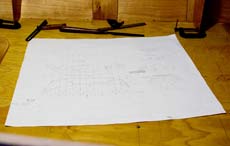 |
 |
Patterning is somewhat time-consuming but there is no complex “lofting” required. A plywood panel is marked off in one foot increments and measurements are all made from the plywood factory edge. To further simplify, the topside panels have straight line edges and panels are joined with epoxy glued doubler pads which reinforce the hull and provide a simple and efficient method to join the factory edges.
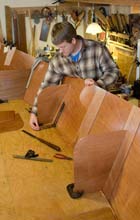 |
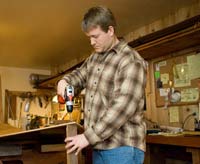 |
This technique works best using hardwood ply—mahogany, okoume—but getting good hardwood ply can be a problem in many parts of the country. Shipping can add to the cost, but hardwood ply works best with epoxy and unlike domestic softwood ply does not have to be sheathed with glass cloth. Hardwood ply also has very appealing face veneers, which is why so many of these boats are finished natural, and is also available in metric thicknesses allowing the builder to easily engineer the boat to suit usage. All lumberyards can special-order hardwood ply, but are often reluctant to deal with the hassle of small quantity orders. For consistent quality hardwood ply and small quantity shipping we have been pleased with Edensaw Woods, edensaw.com (800) 745-3336. Plywood is the heart of the boat and you usually get pretty much what you pay for with plywood.
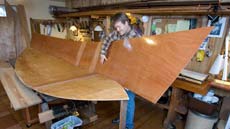 |
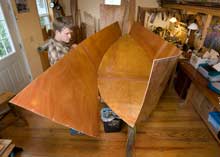 |
Hull components are sealed with an epoxy coating that prevents watersoak, increases abrasion resistance and simplifies long term maintenance. The plywood hull is held together with concave shaped beads of thickened epoxy and strips of fiberglass tape applied to the exterior seams. The hull is constructed by lacing together thin plywood panels with plastic ties. The ties are gradually tightened to hold components in position while a concave shaped bead of thickened epoxy is applied to hull seams, often called “stitch & glue” or “tack & tape”. Vertical compartment bulkheads are installed at the same time to secure hull panels at the correct angle. All exterior seams are rounded and fiberglass tape seals and reinforces the exterior chine seam and the bow and transom. Graphite is combined with epoxy to cover the bottom with a tough, very slick and abrasion resistant coating, which allows the boat to be dragged over launch ramps, parking lots and gravel beaches. The epoxy/graphite mixture is applied around and above the chine seam to form a waterline.
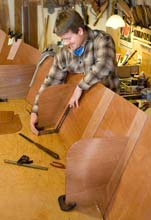 |
 |
Large sealed storage compartments fore and aft provide structural support in the hull, secure dry storage, seating for passengers and a safety margin of emergency flotation should the hull accidently fill with water. In calm water the compartment decks can be used for seating or support while standing to cast, and also provide a handy work or picnic surface. Additional compartments can be added to boats used primarily in whitewater, and are easy to build using the ply/epoxy technique. For serious whitewater versions that are fully compartmentalized, the boat can be made self-bailing by putting a drain in a midship rowers footwell.
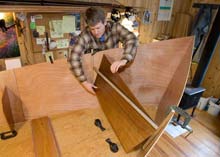 |
 |
Assembling the hull using this technique does not require special tools or woodworking experience and the boat can be built with a minimum of tools including jig saw, circular saw, block plane and a variety of clamps. Rectangular scrapers are especially useful for removing bubbles and lint craters from cured epoxy, and do not gouge or create dust like sandpaper. Duckworks Boatbuilding Supply, duckworksbbs.com, carries a selection of good scrapers. Aside from hardware attachment no other fastenings are required as epoxy and glass tape hold everything securely together, although screws can also be used for clamping specific components and removed after epoxy cures. Building these lightweight ply/epoxy boats is quite different from traditional boatbuilding and with this technique the numerous angled cleats and chine logs to attach and support hull components are not necessary.
 |
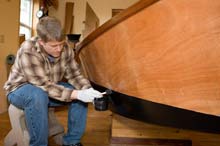 |
The midship seat slides fore and aft to accommodate one, two or three occupants and multiple oarlock sockets are easily installed to accommodate various positions. A solo rower sits amidships, and with a passenger up forward the seat slides aft for proper trim. To trim the boat for a third occupant seated on the aft compartment, the seat can be moved back to center. The midship sliding seat is supported by a handy tackle shelf on each side attached to small partial bulkheads which add support to the ribless hull. Additional compartments can be added for a whitewater version. For additional comfort pivoting plastic seats with backrests can be bolted atop compartments or onto thwart seats, and the midships seat can also be made removable for sleeping aboard under a tent when camp-cruising.
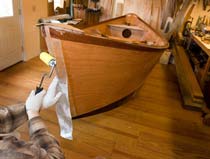 |
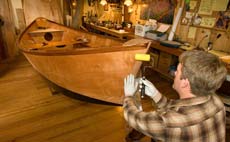 |
With the considerable rocker built into the hull don’t expect stellar performance under power, because this is after all a hull form designed to be rowed or drift with the current. However for slow speed motoring the transom can be reinforced for a tilt-up motor mount and a small gas or electric motor can be fitted for working upstream against current. The convenient aft compartment can be built to isolate and store fuel or a battery inside a watertight compartment, and still function as a seat, and with an extension handle the motor operator can still sit midships if necessary for better trim. But whatever is used for a motor this is still a slow boat, and anything more than a minimal and steady application of power will likely result in porpoising the bow right up out of the water.
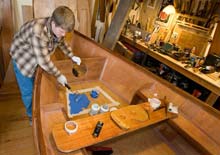 |
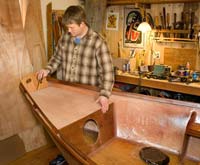 |
The gunwale is a traditional ladder type with spacer blocks separating the inwale and outwale, which provides stiffness to the sheerline of the boat to handle the stress of hard rowing and rough water. The gunwale also provides necessary support when rolling the boat over for storage. The inwale and outwale are mahogany to match the plywood face veneer and for lightweight versions spruce or fir can be used to save weight. Light weight allows a larger payload, but the real advantage comes in getting the boat on and off the water. To make launch and retrieval even easier, with the slick graphite bottom the boat can be dragged over parking lots, launch ramps and gravel beaches preventing having to be lifted or trailered into the water.
 |
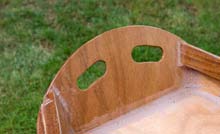 |
For storage of large items compartments can be accessed by traditional hinged yacht-type hatches, and for smaller items plastic screw-out ports come in 6 inch and 9 inch diameters and can be installed in minutes on vertical compartment bulkheads or horizontal decks. Hinged yacht hatches can be built in any practical size and shape with perimeter coamings to help them shed water. Non-skid can be applied to selected spots on deck using a mixture of epoxy, coloring and graded sand.
Building the boat using ply/epoxy technique is quite different but much easier than traditional wood boatbuilding, however for builders who do not wish to use epoxy a more basic version of the boat can also be built using traditional wood boatbuilding methods with timber cleats, caulking and screws.
Building plans include a 30 page booklet of sketches, photos and step-by-step directions, all written for amateur builders. Building plans are $43 from butlerprojects.com or from: paul butler, box 1917, port angeles, wa 98362
Note---plans will be available after publication in the June/July issue of Outdoor Life magazine.
Plans for Clark Fork Drifter are available from
ButlerProjects.com
|

